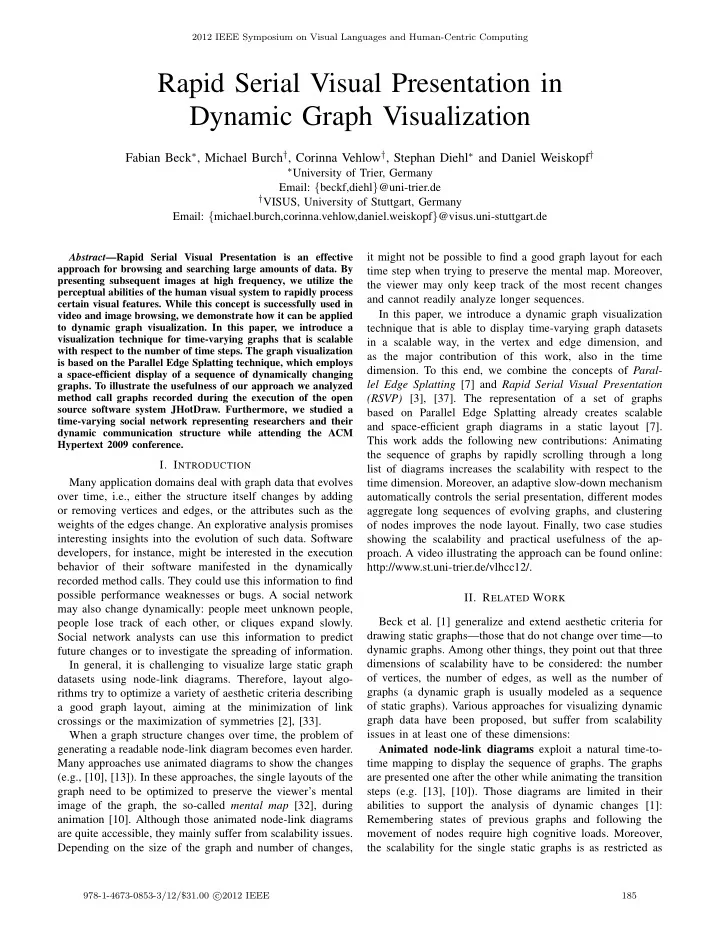

2012 IEEE Symposium on Visual Languages and Human-Centric Computing Rapid Serial Visual Presentation in Dynamic Graph Visualization Fabian Beck ∗ , Michael Burch † , Corinna Vehlow † , Stephan Diehl ∗ and Daniel Weiskopf † ∗ University of Trier, Germany Email: { beckf,diehl } @uni-trier.de † VISUS, University of Stuttgart, Germany Email: { michael.burch,corinna.vehlow,daniel.weiskopf } @visus.uni-stuttgart.de it might not be possible to find a good graph layout for each Abstract —Rapid Serial Visual Presentation is an effective approach for browsing and searching large amounts of data. By time step when trying to preserve the mental map. Moreover, presenting subsequent images at high frequency, we utilize the the viewer may only keep track of the most recent changes perceptual abilities of the human visual system to rapidly process and cannot readily analyze longer sequences. certain visual features. While this concept is successfully used in In this paper, we introduce a dynamic graph visualization video and image browsing, we demonstrate how it can be applied to dynamic graph visualization. In this paper, we introduce a technique that is able to display time-varying graph datasets visualization technique for time-varying graphs that is scalable in a scalable way, in the vertex and edge dimension, and with respect to the number of time steps. The graph visualization as the major contribution of this work, also in the time is based on the Parallel Edge Splatting technique, which employs dimension. To this end, we combine the concepts of Paral- a space-efficient display of a sequence of dynamically changing lel Edge Splatting [7] and Rapid Serial Visual Presentation graphs. To illustrate the usefulness of our approach we analyzed method call graphs recorded during the execution of the open (RSVP) [3], [37]. The representation of a set of graphs source software system JHotDraw. Furthermore, we studied a based on Parallel Edge Splatting already creates scalable time-varying social network representing researchers and their and space-efficient graph diagrams in a static layout [7]. dynamic communication structure while attending the ACM This work adds the following new contributions: Animating Hypertext 2009 conference. the sequence of graphs by rapidly scrolling through a long I. I NTRODUCTION list of diagrams increases the scalability with respect to the Many application domains deal with graph data that evolves time dimension. Moreover, an adaptive slow-down mechanism over time, i.e., either the structure itself changes by adding automatically controls the serial presentation, different modes or removing vertices and edges, or the attributes such as the aggregate long sequences of evolving graphs, and clustering weights of the edges change. An explorative analysis promises of nodes improves the node layout. Finally, two case studies interesting insights into the evolution of such data. Software showing the scalability and practical usefulness of the ap- developers, for instance, might be interested in the execution proach. A video illustrating the approach can be found online: behavior of their software manifested in the dynamically http://www.st.uni-trier.de/vlhcc12/. recorded method calls. They could use this information to find possible performance weaknesses or bugs. A social network II. R ELATED W ORK may also change dynamically: people meet unknown people, Beck et al. [1] generalize and extend aesthetic criteria for people lose track of each other, or cliques expand slowly. drawing static graphs—those that do not change over time—to Social network analysts can use this information to predict dynamic graphs. Among other things, they point out that three future changes or to investigate the spreading of information. dimensions of scalability have to be considered: the number In general, it is challenging to visualize large static graph of vertices, the number of edges, as well as the number of datasets using node-link diagrams. Therefore, layout algo- graphs (a dynamic graph is usually modeled as a sequence rithms try to optimize a variety of aesthetic criteria describing of static graphs). Various approaches for visualizing dynamic a good graph layout, aiming at the minimization of link graph data have been proposed, but suffer from scalability crossings or the maximization of symmetries [2], [33]. When a graph structure changes over time, the problem of issues in at least one of these dimensions: generating a readable node-link diagram becomes even harder. Animated node-link diagrams exploit a natural time-to- Many approaches use animated diagrams to show the changes time mapping to display the sequence of graphs. The graphs (e.g., [10], [13]). In these approaches, the single layouts of the are presented one after the other while animating the transition graph need to be optimized to preserve the viewer’s mental steps (e.g. [13], [10]). Those diagrams are limited in their image of the graph, the so-called mental map [32], during abilities to support the analysis of dynamic changes [1]: animation [10]. Although those animated node-link diagrams Remembering states of previous graphs and following the are quite accessible, they mainly suffer from scalability issues. movement of nodes require high cognitive loads. Moreover, Depending on the size of the graph and number of changes, the scalability for the single static graphs is as restricted as 978-1-4673-0853-3/12/$31.00 c � 2012 IEEE 185
Recommend
More recommend